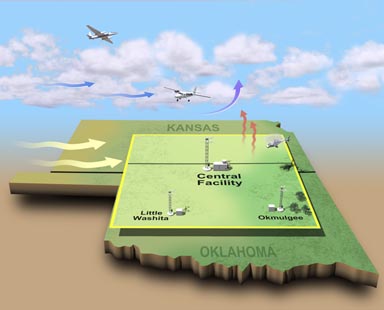Cloud and Land Surface Interaction Campaign (CLASIC)

Three "supersites" in the experiment domain will be heavily instrumented to obtain ground-based measurements to link observed carbon fluxes to atmospheric structure. Nine aircraft—including a helicopter—will fly over the domain, with the SGP site's Central Facility serving as the primary source of information about cloud and carbon feedbacks. The other two supersites are located in pastured lands near the Little Washita Watershed and oak forests near Okmulgee State Park. (Larger image.)

Coordinated by the ARM Aerial Vehicles Program, numerous instrumented aircraft—including the Twin Otter shown here—will fly at various altitudes over the SGP surface sites.
The ACRF is currently making detailed observations of cumulus convection at the SGP. These routine measurments are the basis of the CLASIC field campaign, which will cover a 3-week period in June, a time when the SGP region is likely to be in the process of harvesting the winter wheat. During the harvest period, large changes can occur in the surface albedo, latent heat flux, and sensible heat flux. CLASIC scientists will collect additional data sets, both at the surface and from aircraft, which can be used to improve parameterizations of cumulus convection and associated parameterizations of land surface processes. The results will be used to help decipher the respective roles of local and regional forcing on the observed cloud structure and will lead to improved representation of cloud and land surface feedbacks in climate models.
CLASIC was designated as the core of a 2007 priority for the interagency Water Cycle Working Group of the Climate Change Science Program (CCSP). The field campaign serves as a prototype for the CCSP focus area, Integration of Water Cycle Observations, Research, and Modeling. The purpose of this focus area is to address significant uncertainties associated with the water cycle through a study that comprehensively addresses the water budget within a limited spatial and temporal domain. The campaign features concurrent contributions from NASA, NOAA, and USDA to extend CLASIC's time and space domain to capture the seasonal time scale and regional processes, and expand the observational framework by adding space-based observations, aircraft campaigns, surface and subsurface hydrologic components, isotopic measurements, CO2 fluxes, and associated modeling.
CLASIC scientists have also developed a strong collaboration with the North American Carbon Program's (NACP) Mid Continent Intensive (MCI) study. The two teams recognize that there is significant synergy possible between measurements in SGP and northern MCI, particularly because air masses are flowing from south to north, and the influence of the land surface on atmospheric concentrations can be modeled and tested over large areas. CLASIC is also collaborating with DOE's Atmospheric Science Program's Cumulus Humilis Aerosol Plume Study (CHAPS). The two science teams have evaluated the science questions posed for each campaign and have identified overlaps that would benefit both experiments.



